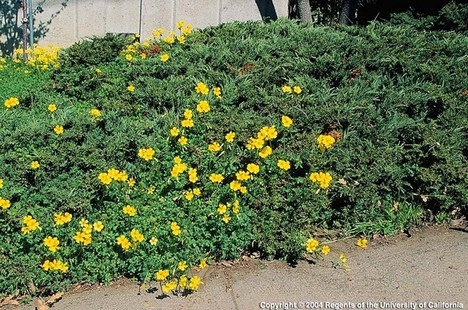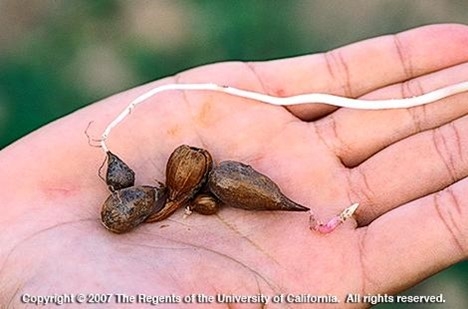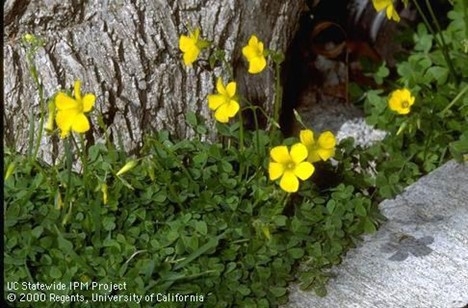Posts Tagged: Weeds
Weeds and Weed Seeds
Note: This was originally published in the Contra Costa Times
Conquer weeds by understanding their life cycles
As a gardener in Contra Costa County, you know from observation that weeds have an immense capacity to produce seeds. In fact, the high reproductive output of weeds is astounding. Per plant, pigweed produces 117,400 seeds, mullein 223,200, lambsquarters 72,450, shepherd's purse 38,500, johnsongrass 80,000, curly dock 29,500, and wild mustard a mere 16,000 seeds.
Weed flowers can be small and inconspicuous, but, after flowering profusely over a period of several months, they produce a tremendous quantity of seeds. Black medic, kikuyugrass, and spotted catsear flower 5 to 7 months. Dandelions bloom 9 months out of the year and each flower produces thousands of wind-borne minutely barbed pappus-bearing seeds which can germinate year-round.
The sheer quantity of seeds ensures waves of seedlings. Yet, germination is discontinuous: it doesn't happen all at once. In gardens and in other disturbed areas, seeds are stored in the soil until shallow tillage brings them to the surface where conditions for germination are ideal.
Weed seeds persist in the soil below the germination zone and can be viable for a surprisingly long period of time. Mustard seeds thought to be 600 years old were excavated from a monastery garden in Denmark and 11 of them germinated. The longevity of field bindweed seeds is over 50 years. Lambsquarters seeds are viable for 20 to 50 years. Grass seeds tend to live an average of 3 to 10 years, whereas broadleaf weed seeds can be part of the soil seedbank for a much longer time
Life Cycle of Weeds:
Like other members of the plant kingdom, weeds are classified as annuals, biennials or perennials. The seeds of summer annuals germinate in the spring and mature plants generate seeds in summer and fall. Winter annuals sprout in the fall, live through the winter and produce seeds during the winter and spring. Biennial weeds spend their first year producing leaves before they flower and bear seed during their second and final year of life. Perennial weeds propagate by seeding but also vegetatively by means of creeping roots, rhizomes, taproots or bulbils. Weeds in their various stages of growth, flowering, seed production and dispersal are with us all year.
Weed Seed Dispersal:
Weed seed dispersal is varied and opportunistic. Though many mature weed seeds fall next to the parent plant, quantities of others are tumbled along or parachuted for miles by wind. Some burst out of capsules, landing 3 to 15 feet away. Others hitch a ride by attaching themselves to animal fur with burs or seed hooks. Many are digested by birds or livestock, transported by water or by the gardener's boots and tools. In their quest for territorial expansion, weeds use gardens as seed factory sites, as seed storage facilities and as launching pads for seed dispersal by gardeners.
Production of large quantities of seed, opportunistic seed dispersal, long- flowering periods, long seed viability, year-round seed production, and
discontinuous germination are successful strategies that weeds use to ensure their survival and expansion.
Managing Weed Seeds:
Weed seed management works best if you combine methods of control. Choose an irrigation system such as drip irrigation or microsprinklers so that only your plantings are watered. Be aware that cultivation brings weed seeds to the surface where they can germinate. Do not let weeds go to seed and replenish their weed seed reservoir in the soil. Reduce weed seed germination by eliminating their light source through use of a thick layer of mulch.
For More Information:
If you would like more information about identification of and controls for specific weeds, consult these University of California web sites:
https://wric.ucdavis.edu/
http://ipm.ucanr.edu/PMG/menu.weeds.html
http://ipm.ucanr.edu/PMG/PESTNOTES/pn7441.html
Help Desk of the UC Master Gardeners of Contra Costa County (CG)
Using Native Plants for Weed Control
One of the first steps in ecological restoration is often controlling invasive weeds, which can be a major barrier to native plant establishment. But what happens after restoration is complete? At most sites, weed pressure is an ongoing challenge that...
Lawn-pocalypse! Surviving Drought
Ah, summer! The season of sunburns, pool parties, and… lawn droughts. If your once lush, green carpet now looks like a crunchy brown doormat, you're not alone. Let's dive into why your yard is staging a dramatic death scene and what you can do to...

Bermuda grass and weeds overtaking drought stressed turf grass.
Frequent mowing puts poisonous weed into survival mode
Pair of studies offers evidence into "superweed's" defensive tactics, strategy FAYETTEVILLE, Ark. — A study of the effects of mowing on a common weed has found that what doesn't kill you can make you stronger. A study published in...
Bermuda Buttercup
Bermuda buttercup (Oxalis pes-caprae) has become a tenacious and frustrating weed throughout California. From November through April, bright yellow flowers on leafless stalks and green shamrock-like leaves pop up in many of our landscapes. While it was brought from South Africa as an ornamental plant, it escaped cultivation on its route to being a chronic nuisance. It competes with other plants and is very difficult to control.
Bermuda buttercup develops from underground bulbs that produce a single vertical stem. A loose rosette of leaves will appear at soil level after the first rain. Small, whitish bulblets develop on the stem, and new bulbs form underground. Each plant can produce about a dozen small bulbs each year that easily detach from the plant and will increase the plant's spread quickly.
A couple of our favorite vertebrate pests (gophers and voles) consider oxalis bulbs to be a yummy food source and can spread the bulbs to new locations as they carry them back to their underground dens.
The best way to control Bermuda buttercup is to prevent its introduction into your garden. Don't move soil or plants from an infested site to another location that is free of the weed. Unfortunately, for many of us, it's too late for that tactic. So, what can we do when faced with the cheery yellow flowers popping up throughout the landscape?
Hand pulling can provide control if the entire plant is removed, including the underground rhizome and bulb. It's difficult to find all the bulbs without sifting the soil very carefully. Repeatedly removing the tops of the plants will eventually deplete the bulb's resources, but it can take years to be successful. It's important to remove the tops of the plants before they flower and form new bulbs.
It is difficult to smother Bermuda buttercup with thick mulch or even weed block cloth because it is a strong plant. If cardboard covered with a thick layer of mulch is used to try to smother the weed, continued vigilance in monitoring and pulling new growth will be needed in subsequent years. In one garden, weed cloth was laid under a brick walkway. The following winter, Bermuda buttercup pushed its way up through the weed cloth between the bricks. This made removing the plants even more difficult because the plants were being held in place by the weed cloth.
Several herbicides will effectively kill the tops of the plants, but will not kill the bulbs, so regrowth will occur.
Whatever method you choose to combat a Bermuda buttercup invasion, you will need to be persistent and prepared to continue in subsequent years.
For more information about managing Bermuda buttercup, see this web page: https://ipm.ucanr.edu/PMG/PESTNOTES/pn7444.html
Help Desk of the UC Master Gardeners of Contra Costa County (SEH)

oxylis2-468

oxalis corms

oxylis3



